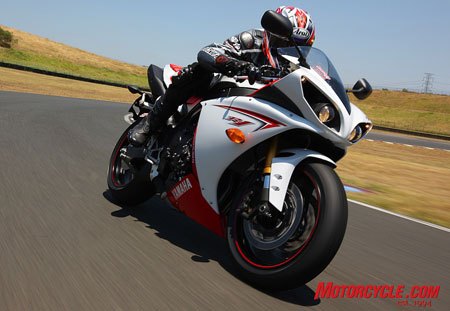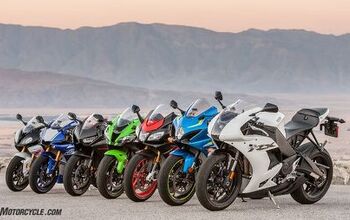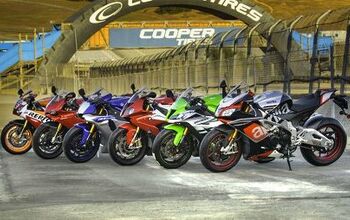2009 Yamaha R1 Review - Motorcycle.com
Get the Flash Player to see this player.
This new crankshaft arrangement is part of Yamaha’s latest YZF-R1, a literbike we tested last week at the Eastern Creek circuit in Australia, and it’s a design not seen in any previous production motorcycle.
The 998cc engine’s distinct sound is the obvious clue that it’s something special - it’s akin to a V-Four with a deep, purposeful note that seems a little bit angry. But it’s in the way the motor generates power that sets it apart from its competition. Gone is the peaky powerband of the previous motor, and in its place is the most tractable four-cylinder literbike yet built.
The newly enhanced midrange is welcome, but more than that is the feel of a direct connection between the throttle and rear tire. In most literbikes, a rider is acutely aware of the possibility of being high-sided to the moon if the throttle is applied injudiciously. With the R1, even a moderately skilled rider can safely drift the rear tire on corner exits.
What’s a Cross-plane Crankshaft?As high-performance motorcycle engines have grown more powerful, it’s become difficult to harness that power through the small contact patch on the rear tire.
A typical four-cylinder engine uses a flat-plane crankshaft, and the two outer and two inner pistons rise and fall in pairs, firing 180 degrees apart. Torque is applied to the crank during combustion, of course, but also from inertia as the crankshaft rotates. This inertial torque is seen as noise to engineers, and it has the effect of confusing a rider about the amount of traction available from a bike’s rear tire.
The same holds true in the world of MotoGP racing, so Yamaha engineers introduced in 2004 an uneven firing interval for its inline four-cylinder M1 with what’s called a cross-plane crankshaft. In this new design the pistons are arranged 90 degrees apart from each other around the crank, which eliminates the inertial torque fluctuation of a typical four-cylinder mill. A balance shaft keeps vibration at tolerable levels. Yamaha has adapted this configuration to its R1 streetbike, providing enhanced traction and a very distinctive exhaust note we’ve been hearing from Valentino Rossi’s racebike.
In the 600cc and 1000cc supersport categories, the successful mantra has always been lighter weight and more power. But with a claimed 182 crankshaft horsepower, the new R1 doesn’t re-set the bar in power production. And its 454 lb running weight (full of fuel, etc) is 15 up on the svelte Honda CBR1000RR.
Instead, Yamaha has focused on its stated concept for the R1: “To deliver a maximum amount of drive force in the smoothest manner possible.” We’re happy to report that this isn’t just some PR hype - it’s actually something a rider can feel after just a short time in the saddle.
One of the knocks against the old R1 was its lethargic response when leaving stoplights. The new engine’s beefed-up midrange sure helps in this regard, aided by two extra teeth on the rear sprocket. Quick launches no longer require major clutch slippage, making around-town riding much easier to manage.
In terms of its chassis, the R1 doesn’t break as much new ground as its engine. Rake and trail remain unchanged, while the wheelbase is shortened by a scant 5mm. Nevertheless, the R1’s frame is an all-new design with a significantly revised rigidity balance.
Made from a mixture of gravity-cast, CF-cast and pressed-sheet aluminum, the frame is stiffer at the steering head and swingarm pivot, but its perimeter frame rails are now 37 percent more flexible laterally, providing greater feedback when the bike is leaned over in a corner. The swingarm also had its rigidity balance tweaked, allowing more flex laterally and torsionally.
Around the Eastern Creek circuit, the new R1 proved to be quite cooperative. Turn-in response is about what we’ve come to expect from a literbike, aided somewhat by the use of a taller 55-series rear tire rather than the typical 190/50-17. There are several mid-corner bumps around the Aussie racetrack, and the Yamaha was quite adept at sucking them up without throwing the bike off its trajectory.
Helping keep things stable is a nifty steering damper. Like the previous model, the damper has a check ball that engages when the handlebars wag back and forth too quickly. This mechanical system is aided by a new electronic component that engages a damper valve when vehicle speeds surpass 125 mph or when the throttle is twisted past the halfway point.
A totally new suspension system is up to the task of smoothing out the ride. Up front is a Soqi fork that has its damping circuits divided between each leg. Oil flow is simplified by having the left leg handle only compression damping and the right tube controlling only rebound damping. Yamaha reps claim this design minimizes cavitation (air mixing with the oil). At the rear, a bottom-link suspension has a more progressive ratio to make fuller use of its travel, and the addition of a hydraulic preload adjuster makes setting up the bike easier.
A revision to the engine architecture allowed it to be placed further forward in the frame, shifting the weight distribution slightly towards the front end. To best centralize mass, fuel is now carried lower between a rider’s legs and a lightweight magnesium subframe replaces an aluminum component.
Cross-plane Crank For Next R6?Since the R1’s new firing order appears to be successful, it begs the question about whether this system can be incorporated into Yamaha’s 600cc sportbike, the YZF-R6. So we questioned the R1’s project leader, Toyoshi Nishida, about whether we might see this configuration in the middleweight screamer.
He told us that because a 600’s power output isn’t nearly as potent as a literbike’s, racers in the smaller class usually apply only full power, so the cross-plane’s part-throttle benefits wouldn’t be so obvious. He added that the counter-balancer necessary with the cross-plane arrangement would sap some power, hence it wouldn’t be the most efficient way to provide that direct connection to rear-tire traction for a 600.
However, he hinted that there is another way to aid rear-tire traction, and one that doesn’t involve electronics. Curious about what he referred to, I asked if there was the possibility of using a single-plane crankshaft arrangement in which the two paired pistons fire at the same time (instead of 180 degrees apart), similar to a project used a few years ago in the British Superbike championship on a Yamaha R1. That engine proved to work well in wet conditions, but it was soon outlawed by race organizers.
Nishida-san’s response indicated I was barking up the wrong tree, but any loyal engineer would naturally want to keep information like that to himself. Whatever the case, we may see something special in the engine compartment when the next R6 is revealed.
When it comes to slowing down, the R1 has an upgraded braking system. Although the front brake discs are 10mm smaller in diameter (310mm), they proved to have excellent power and feel. They still use six-piston, radial-mount calipers, but the rotor carriers are now more rigid.
There is only one really heavy braking zone at Eastern Creek, but the R1’s brakes demonstrated terrific feedback and were easy to modulate. A ramp-type slipper clutch aided corner entries, allowing quick downshifts without worrying about the rear tire locking up during compression braking. A new gear-position indicator lets a rider keep track of what’s going on in the transmission.
Yamaha has joined the electronic engine-control bandwagon by incorporating a D-mode selector that allows a choice of three engine-response maps. Unlike Suzuki’s DMS, Yamaha’s system does not affect ECU settings - the performance curve of the engine always stays the same, and it’s only alteration is the response from Yamaha’s Chip Controlled Throttle (YCC-T). The default Standard mode is said to be optimal. The A-mode provides sharper initial throttle response but the same performance as Standard up top. Response from B-mode is 30 percent slower at all throttle settings.
In practice, I preferred the Standard mode, as it allowed smooth response that was amazingly cooperative. A-mode made throttle application a bit touchier but still quite manageable. B-mode provided more leisurely responses that weren’t ideal for cutting quick lap times, but it would be a good choice when road conditions are a bit dicey, such as during damp or wet conditions. Unlike Suzuki’s system, engine response isn’t neutered to 600cc-class power levels.
The R1’s Mikuni fuel-injection system now incorporates the latest 12-hole squirters, augmented by secondary injectors. As in the previous R1, Yamaha’s variable-length inlet tracts (YCC-I) help broaden its powerband. The intake funnels stay in their long form below 9,400 rpm, then flip open to their shorter length for enhanced top-end pull.
Yamaha says the R1 produces 182 hp at 12,500 rpm, which should be enough for anyone riding on the street. But ratcheting up through the gears along Eastern Creek’s front straightaway, the Yamaha’s upper-rev pull didn’t feel as mind-numbing as something like the Kawasaki ZX-10R. Either this new engine’s broader powerband made it feel a bit duller or its ultimate peak power isn’t as plentiful as its burliest competition. Regardless, for a streetbike application this distinctive new engine configuration is much preferred over the previous version.
And the engine output doesn’t hurt the R1’s racetrack performance, either. Yamaha’s test rider Jeffry de Vries was able to lap Eastern Creek in the 1:37 range on the latest R1. On the previous model, his best lap was in the high 1:39 range. This bodes well for American Ben Spies who will be riding the Yamaha in the upcoming World Superbike season.
It should be noted that American-spec bikes produce six horsepower less than Euro versions thanks to smaller muffler internals that keep noise within US limits. The exhaust system continues its four-two-one-two configuration, exiting into dual underseat titanium mufflers, but it now goes without Yamaha’s EXUP exhaust valve.
In terms of street use, the R1 now offers a slightly more hospitable riding position. Its handlebars are 10mm closer to the rider, and the seat is placed 8mm forward. Footpegs are situated 10mm forward, and they are now repositionable 15mm up and 3mm rearward. Only truly fast riders will need the pegs in their more aggressive position.
The Verdict
In my decade-plus career in moto-journalism, I’ve had to sift through reams of PR propaganda to discern mostly incremental increases in performance of sportbikes. Lose a few pounds here, add a couple of percent horsepower there. So it was with great delight that I found a palpable shift in technology when testing the new R1 that provides a real-world advancement in engine design.
Believe the PR hype this time around. Yamaha’s new YZF-R1 provides literbike performance in a package that benefits not only racers, but also lesser-skilled street pilots. With the addition of the cross-plane crankshaft engine, it’s safe to say that Yamaha has upped the ante in delivering mega performance in a package that will benefit riders of all types. And it sounds marvelous.
Good on ya, Yamaha!
Duke's Duds- Lid: Arai RX-7 Corsair
- Skin: Joe Rocket Speedmaster 5.0
- Gloves: Joe Rocket Speedmaster 7.0
- Boots: Alpinestar Supertech R
More by Kevin Duke








































Comments
Join the conversation